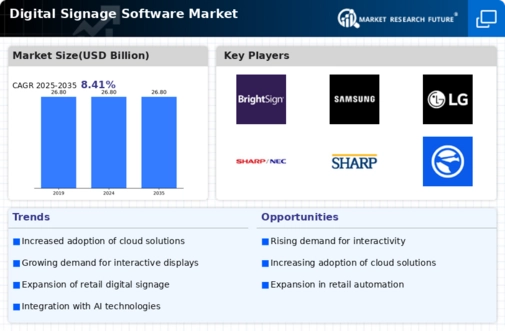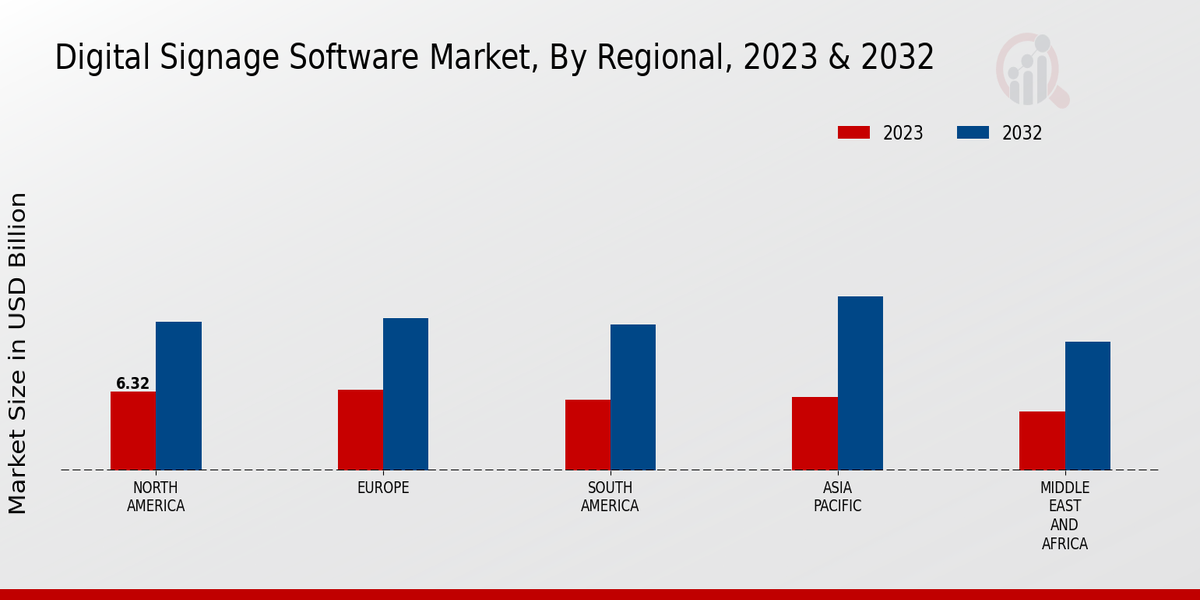Expansion of Smart Cities
The Global Digital Signage Software Market Industry is poised for growth due to the expansion of smart cities worldwide. As urban areas increasingly adopt smart technologies, digital signage plays a crucial role in disseminating information to residents and visitors. From public transportation updates to emergency alerts, digital signage enhances communication and improves the quality of urban life. This trend indicates a potential for sustained market growth as cities invest in infrastructure that incorporates digital signage solutions. The market's projected stability at 26.8 USD Billion in 2024 reflects the growing recognition of digital signage's role in smart city initiatives.
Market Growth Projections
The Global Digital Signage Software Market Industry is projected to maintain a steady valuation of 26.8 USD Billion from 2024 through 2035, with a CAGR of 0.0% for the period between 2025 and 2035. This stability suggests a mature market where growth may be driven by technological innovations and evolving consumer preferences rather than rapid expansion. The focus may shift towards enhancing existing solutions and improving user experiences rather than seeking new markets. This long-term projection indicates that while the market may not experience significant growth, it remains a vital component of digital communication strategies across various sectors.
Technological Advancements
The Global Digital Signage Software Market Industry is experiencing a surge in demand due to rapid technological advancements. Innovations in display technologies, such as OLED and 4K resolution, enhance visual appeal and engagement. Furthermore, the integration of artificial intelligence and machine learning into digital signage software allows for personalized content delivery, improving user experience. As organizations increasingly adopt these technologies, the market is projected to maintain a steady valuation of 26.8 USD Billion in 2024, indicating a robust interest in cutting-edge solutions that drive customer engagement and operational efficiency.
Emergence of Cloud-Based Solutions
The Global Digital Signage Software Market Industry is being transformed by the emergence of cloud-based solutions. These platforms offer scalability, flexibility, and cost-effectiveness, enabling businesses to manage their digital signage networks more efficiently. Cloud-based software allows for centralized content management and real-time updates, which are essential for organizations with multiple locations. As more companies transition to cloud solutions, the market is expected to maintain its valuation of 26.8 USD Billion in 2024. This shift towards cloud technology is likely to redefine how businesses approach digital signage, making it more accessible and manageable.
Increased Adoption in Retail Sector
The Global Digital Signage Software Market Industry is significantly influenced by the increased adoption of digital signage in the retail sector. Retailers are leveraging digital displays to showcase promotions, product information, and advertisements, thereby enhancing customer engagement and driving sales. The ability to update content remotely and in real-time allows retailers to respond quickly to market trends. This trend is expected to contribute to the market's steady valuation of 26.8 USD Billion in 2024, as retailers continue to invest in digital signage solutions to create immersive shopping experiences and improve operational efficiency.
Growing Demand for Interactive Signage
The Global Digital Signage Software Market Industry is witnessing a growing demand for interactive signage solutions. Businesses are increasingly recognizing the value of engaging customers through interactive displays that allow for real-time feedback and interaction. This trend is particularly evident in retail environments, where interactive kiosks and touchscreens enhance the shopping experience. As a result, the market is expected to sustain its valuation of 26.8 USD Billion in 2024, reflecting the importance of interactive technologies in attracting and retaining customers. This shift towards interactivity is likely to shape future developments in digital signage.















